Local marketing is becoming more important than ever, especially with local stores needing to move online due to the pandemic.
But even before COVID-19 struck, almost half of Google searches showed local intent with a third of consumers checking local businesses online every day.
In this guide, we’ll take a look at what local marketing is, some examples of successful local marketing campaigns, and how you can promote your business with local marketing.
Let’s begin.
What is Local Marketing?
Local marketing is a strategy that targets potential customers within a specific radius – typically 50 miles – of the physical location of a business. It’s also known as location-based marketing, neighbourhood marketing, or local store marketing.
Local marketing can work for any brand that has a physical brick-and-mortar location, like shops and bars, or any locally-based businesses that travel to a customer’s location, such as plumbers and electricians.
Local businesses can use a range of outbound and inbound marketing methods to attract customers, including:
- Inbound: Google My Business, Local SEO, social media marketing, etc.
- Outbound: Display ads, attending local events, community involvement, etc.
(We’ll look at more of these later…)
Local Marketing vs Global Marketing
Local marketing is different from global marketing.
Most marketing advice focuses on global (or general) marketing, like a software service. But local businesses don’t need global reach – they need to target their community.
One of the potential dangers with local marketing is that you can think too big and waste time and money on the wrong location and audience.
For example, if you have a dental practice located in Sydney, you should target “dental practice in Sydney” rather than the generic term “dental practice” so that you reach people in your local area.
93% of consumers say they won’t travel more than 20 minutes from home to make an everyday purchase. So make sure you direct all of your efforts at the right person within a precise geographic area.
Why is Local Marketing More Important Than Ever?
Local marketing is especially important for small and medium-sized businesses that rely on people visiting their physical location to purchase goods or access a service, including shops, dentists, physiotherapists, bars, restaurants, and car dealerships.
Consumers rely on referrals and the internet to find those local businesses:
- 85% of business owners depend on word-of-mouth referrals.
- 90% of consumers have used the internet to find a local business.
- 33% of consumers look at local businesses online every day.

The good news is that Google’s search algorithm uses a searcher’s location to display relevant local businesses, even if a user doesn’t specify a location or use “near me” in their query.
For example, if you enter a generic term like “coffee shop”, the first results that Google displays are the coffee shops local to you:

3 Examples of Successful Local Marketing Campaigns
Let’s take a look at some examples of successful local marketing campaigns for different-sized brands.
Nike
Leading global brand Nike used the creative agency, Wieden + Kennedy, to develop a London-specific marketing campaign called “Nothing Beats a Londoner.”
The ads focused on being a young sportsperson in London and were filmed in lesser-known areas of London, like Peckham and Dalston, featuring Nike athletes such as Dina Asher-Smith and Harry Kane.
Each of the athletes posted their scene as a standalone piece of content on Instagram, linking to the next competitor to create a “massive social media battle.” The full version of the film was later broadcast across TV, cinema, and online.
According to the fashion search platform Lyst, London searches for Nike products were up 93% following the ad’s launch. And as a spin-off, Nike searches were also up 72% in Manchester and 54% across the UK.
Airbnb

Airbnb has grown to 7M+ listings worldwide, covering more than 100K cities and over 220 countries and regions. But although Airbnb is a global brand, they’ve used localized marketing to both hosts and travellers.
They’ve created content targeting specific markets using their Airbnb magazine (available online and in print), country-specific social media campaigns (in the local language), trusted city guidebooks, and local host-led experiences for tourists.
Brent Jones

Real estate agent Brent Jones doesn’t just sell homes – he’s an integral part of the Fort Erie community.
On his social media pages, you’ll find examples of contests, giveaways, contactless and curbside bottle collections for charity (during COVID-19), plus glowing 5-star reviews and real estate listings.
Plus, Brent also hosts the Fort Erie podcast featuring members of the local community.
His mix of online and offline local marketing activities makes sure he’s front of mind when Fort Erie residents want to sell or buy their next home.
How to Promote Your Business With Local Marketing
In this section, we’ll explore the digital marketing strategies and platforms you can use to market your business, split into three parts:
- Local SEO
- Content Marketing
- Paid Advertising
1. Local SEO
Local SEO aims to increase the visibility of local businesses in search results, location pages, and online maps. It’s a vital part of local marketing:
- 46% of all searches in Google have “local intent.”
- “Near me” mobile searches have grown over 500% over the last two years.
- 29% of all Google SERPs contain a local pack in the results.
The Map Pack (Local Pack)
If you’ve done any local searches, you’ll be familiar with the “Map Pack,” also known as the “Local Pack” or “3-Pack”. It’s the set of three local business results and a map that appear at the top of the search results page. For example, if you search for “pest control kambah”, you’ll see something like this:
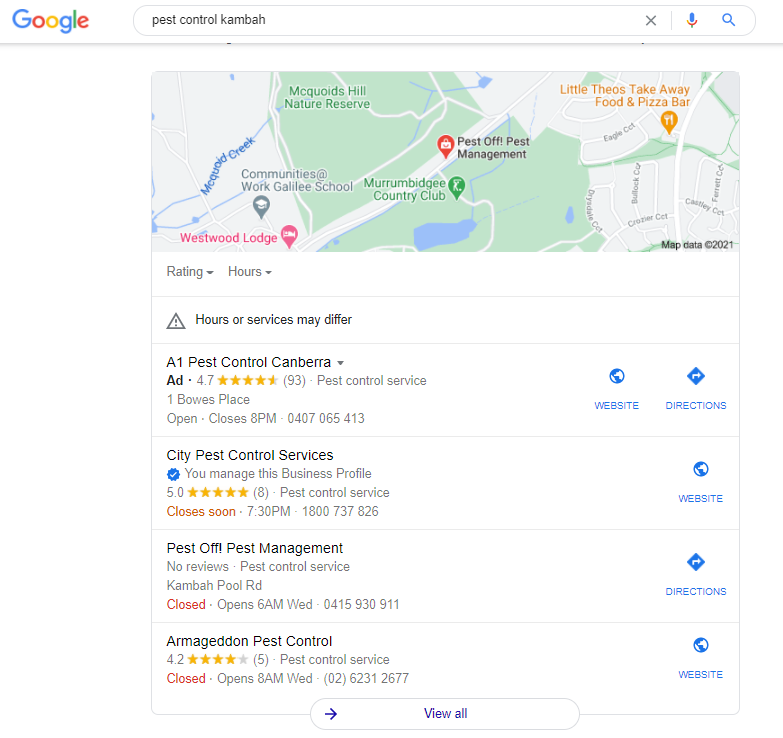
Let’s take a look at how you can get your business featured in the Map Pack.
Major local ranking factors
Local SEO works much the same as “normal” SEO. However, Google uses a different set of ranking signals, including:
- The location that the person is searching from
- NAP citations
- Presence of Google My Business listing
- Keywords used in Google My Business profile
- The sentiment of online reviews
- Keywords used in online reviews
- Number of “check-ins” at that location
- Shares on social media
- Google Maps star rating for that business
According to a Moz survey, these are the major local search ranking factors:
- Google My Business Signals (Proximity, categories, keyword in business title, etc.) 25.12%
- Link Signals (Inbound anchor text, linking domain authority, linking domain quantity, etc.) 16.53%
- Review Signals (Review quantity, review velocity, review diversity, etc.) 15.44%
- On-Page Signals (Presence of NAP, keywords in titles, domain authority, etc.) 13.82%
- Citation Signals (IYP/aggregator NAP consistency, citation volume, etc.) 10.82%
- Behavioural Signals (Click-through rate, mobile clicks to call, check-ins, etc.) 9.56%
- Personalization (E.g. area-specific targeting) 5.88%
- Social Signals (Google engagement, Facebook engagement, Twitter engagement, etc.) 2.82%

As you can see, Google My Business is the most important, so let’s start there.
Optimize your Google My Business (GMB) listing
Google My Business (GMB) is Google’s free local business directory. If you want to appear in the search results on Google as a local business, then you’ll need to get a GMB profile.
The key to creating and optimizing your GMB profile is consistency. Google feeds the GMB profile data to search results, so everything you enter into your profile must match the details on your website, plus your NAP citations around the web.
In short:
- Confirm your information is up to date.
- Select the correct business category (and secondary categories).
- Check all settings and input fields are accurate and relevant.
When all your information is consistent, then Google can see you’re a legitimate business. The more information you provide, the better your profile will look in search results.
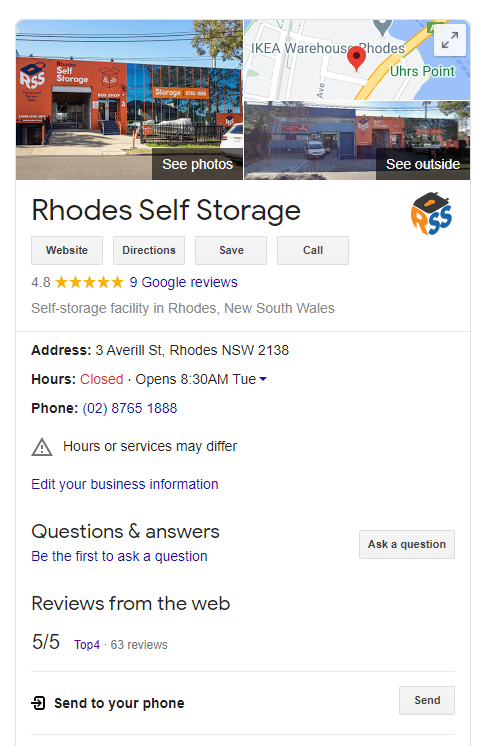
Gather reviews and testimonials
Reviews are another important ranking factor, so it’s important to get as many positive reviews as possible. But whether it’s a positive or negative review, you should reply to all of them to show that you care. Plus, you can always turn a negative into a positive.
Positive reviews can help in 3 ways:
- Reviews are a ranking factor in local search results.
- Great reviews on your GMB profile will lead to a higher click-through rate.
- Positive reviews create social proof and build trust in your business.
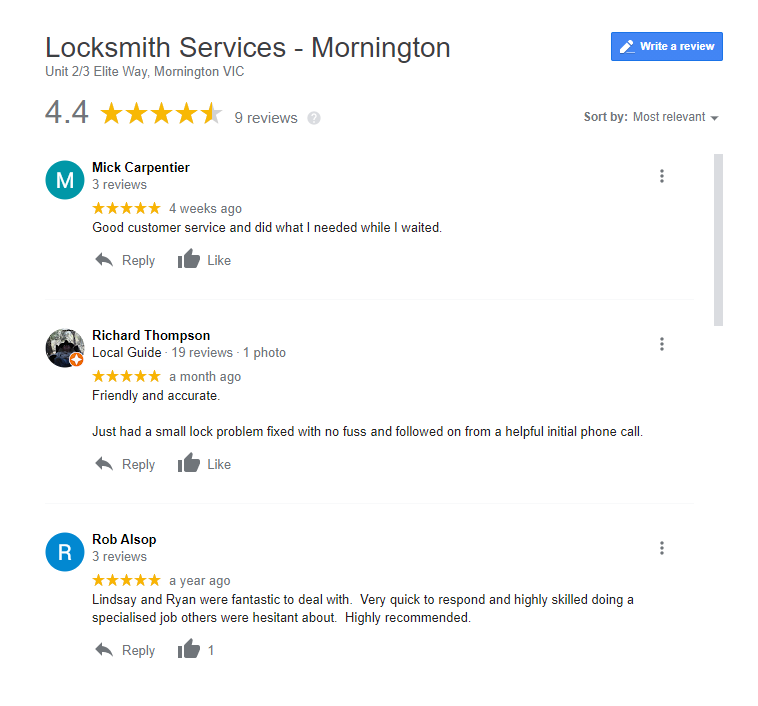
According to BrightLocal, 91% of consumers say that positive reviews make them more likely to use a business:

Expand your citations
Citations play a significant role in local search results. A citation, also known as a NAP (Name/Address/Phone), refers to any mention (with or without a link) of your business online.
The more citations you have, the better, as it makes your business more credible to Google. But, like GMB listings, you need to ensure your NAP is correct and consistent on every citation.
Try to find local directories and websites where you can list your business. For example, you could search for “business directory + town/city” or your local .gov and .edu sites like “www.[town].gov”. You can also check to see where your competitors are listed.
There are also global sites that serve as business directories, including Google, Facebook, YouTube, Apple Maps, Bing, Yelp, and Tripadvisor.
Data aggregators like Factual, Neustar, Foursquare, and Infogroup are massive databases built from various listing sources, including Yellow Pages, phone directories, and utility records that provide citation (NAP) information to search engines.
You can use a service like the BrightSpark Citation Builder to manage all your citation and aggregator submissions so that your data is consistent everywhere.
Optimize your website
A local business website needs to load quickly and be mobile-friendly. Consumers are impatient, and whether they’re searching on desktop or mobile, they’ll want to see results quickly and clearly. Plus, Google’s primary search index is mobile-first, so mobile optimization is a must.
You’ll also need to consider your site structure, especially if you have more than one business location. For example, a plumbing business with locations in Los Angeles and San Francisco might look something like this:
- https://www.heroplumbing.com/locations/los-angeles-ca/service-areas/area1
- https://www. heroplumbing.com/locations/san-francisco-ca/products/product1
- https://www. heroplumbing.com/locations/san-francisco-ca/services/service1
Also, here is the other example of a locksmith business with multiple locations:
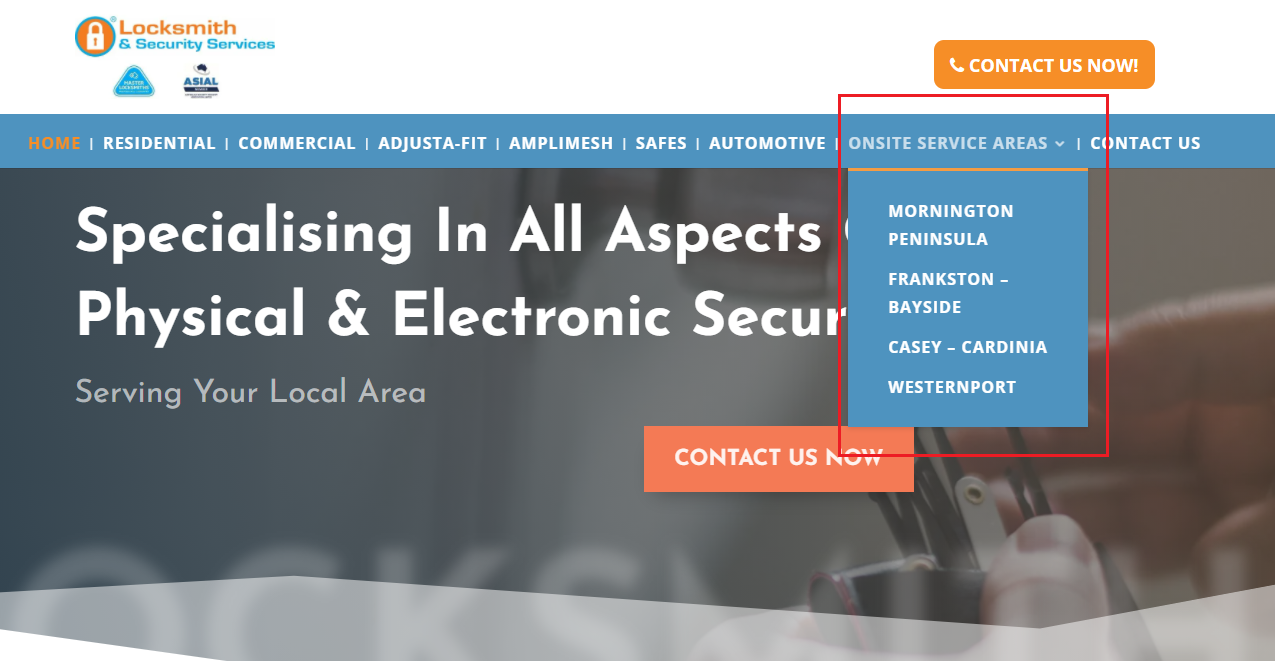
As a local business, you’ll want to include relevant information on your website, including:
- Business name, address, phone number (NAP)
- Opening hours
- Services or products you offer
- Reviews and testimonials
- Areas you cover
- An embedded map
- Parking info
2. Content Marketing
Content marketing can build trust, drive traffic, generate leads, and keep customers loyal, and is perfect for local marketing.
Target local email marketing
Email marketing is highly effective, but often overlooked, medium when it comes to local marketing.
A solid email marketing strategy will help you:
- Build a list of prospective customers.
- Contact customers and prospects through regular newsletters and emails.
- Send offers such as special coupons, discount codes, and events.
- Provide a personalized service based on interactions and transactions.
- Generate visits to your website, telephone inquiries, and foot traffic to your business location.
All of these activities can keep your business in front of your customers and build trust.
Localize your social media marketing
Social media is one of the quickest and most efficient ways to connect with local consumers. But how do you get local on global platforms like Facebook and Instagram? Here are eight ideas to try:
- Set a location in your profile.
- Tag the location of each post.
- Use local hashtags.
- Start conversations on things that are happening locally.
- Share pictures and videos of your brand participating in local events.
- Host contests with local prizes that your community will appreciate.
- Integrate local festivals and customs into your social media posts.
- Share content from local businesses and celebrities.
Hook up with local influencers
Local influencer marketing is another way for small businesses to promote their brand. Just like global influencer marketing, you’ll need to find relevant influencers who can help to promote your products or services to their audience.
Make sure your influencer can reach your target customers via his followers, reflects well on your brand, and only charges a reasonable fee.
Localize your web content
Writing and sharing relevant local content is a tried-and-tested way to reach, engage, and convert local consumers into loyal customers. Focus on creating relevant community content rather than just talking about your products or services.
For example, house buyers moving into a new location will want to research the whole area. That’s why real estate agents include community pages like this one for the Lincoln Park neighborhood in Chicago:

Aside from community pages, you can provide other valuable content. For example, the Windermere Real Estate Blog offers tips and advice on a selection of home-related topics, including buying, selling, market news, community, and architecture.

Providing content like this positions you as a credible source and shows your expertise or authority in a particular location.
3. Paid Advertising (Search and Social)
Paid advertising offers a quicker way to get your local business promoted on both search and social platforms.
Run a PPC campaign
Local PPC search ads can give you targeted exposure, leading to more in-store visits or calls. For example, if someone searches for “electrician near me” they could see your ad at the top of the search results:

Local search ads can feature your business locations, directions, opening hours, and contact options.
Run Google Local Services ads
If you’re a local service provider, you could run a local services ad that displays your details at the top of the search results. For example, if you search for “locksmith los angeles” you’ll see these types of ads:

- Clicking on an individual ad takes you to the business listing page in the Local Services ad unit.
- Clicking on the “More locksmiths in Los Angeles” link takes you to a separate page listing businesses in the Local Services ad unit.
Unlike PPC ads where you choose keywords to target for your business, with service ads, you select your business category, and Google decides the keywords.
But these ads also include a “Google Guaranteed” trust mark because they verify the services before listing them, which is great for consumers.
Try Facebook hyperlocal ads (local awareness ads)
On social media, Facebook offers hyperlocal ads (local awareness ads) that target a small, specific local area. For example, people within a particular zip code. By narrowing your target, you can make a more modest ad budget go further.
You just enter your address, set your radius, gender, and age range, add a photo and message, and Facebook routes the ads to people in the vicinity.

Get listed on a trusted local digital marketing platform
Consumers prefer using this type of site to narrow their search to recommended tradespeople. With Top4, you can be sure that your complete business information is displayed correctly and consistently. Additionally, visitors can ‘dig deeper’ and understand your business, and whether or not your business has something they need, by reading the business’ Description and Overview. Additionally, they can also see photos related to your business through the Gallery, as well as the Products you are offering.
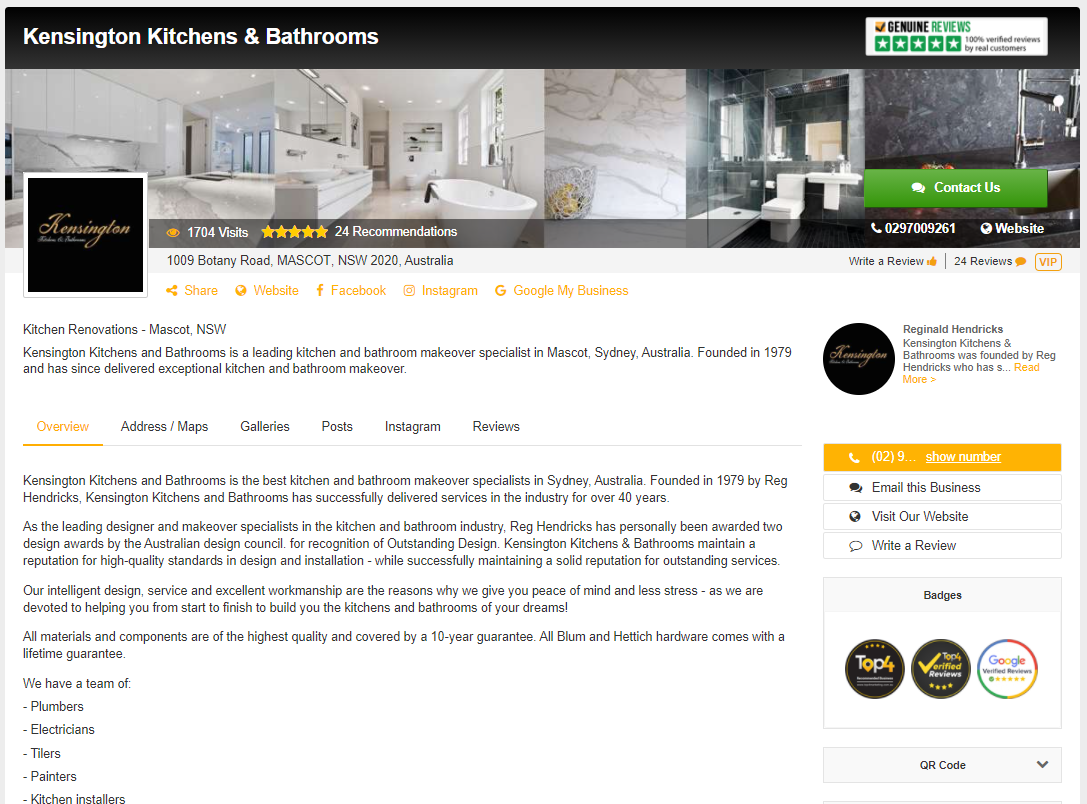
Further local marketing strategies
Here are some offline/physical marketing actions that local businesses can also take as part of a 360-degree strategy, but beyond the scope of this article.
- Create a loyalty program
- Create a referral program
- Launch a coupon campaign
- Offer a free consultation or advice
- Get in the local media – Newspaper/Radio/TV/Blogs/Journalists
- Launch a joint venture with another local business
- Be active in your community
- Host or sponsor local events
- Donate time and talents to a local non-profit
Local Marketing in a Nutshell
Local marketing is on the increase as more and more consumers search nearby for their goods and services.
You can promote your local business with a mix of inbound and outbound marketing activities, including Local SEO, content marketing, and paid advertising to ensure you’re on the radar of consumers in your area.
To find out how we can help you with your Website + Marketing, using our unique location marketing platform called Top4, get in touch today www.top4marketing.com.au
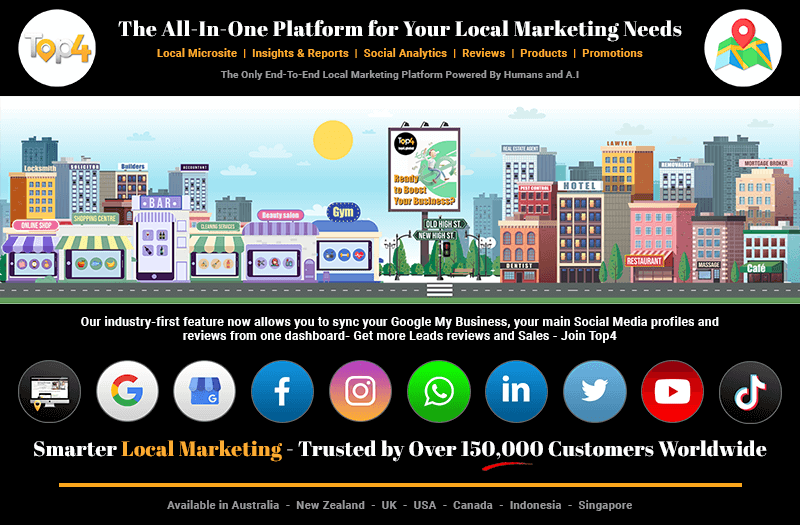
Looking to build customer loyalty through social media? Don’t forget to add your business to Top4.com.au
List your business, create your own digital store to sell goods and services, and share posts on social media. Promote your business on Google instantly! Should you need help with local digital marketing then view our new Google Marketing Platform and services Top4 Marketing
Get Found On Google Promote Your Website, Reach local customers today!
Our Digital Marketing Agency Services Across All Industries Include Search Engine Optimisation (SEO), Google Marketing, Website Design, Corporate Web Development, and local location-based marketing using our own Google Marketing Platform!
Engage A Social Media Agency For Only 1/3 The Cost Of Employing A Social Media Manager…LET’S TALK!
Source: blog.loomy




